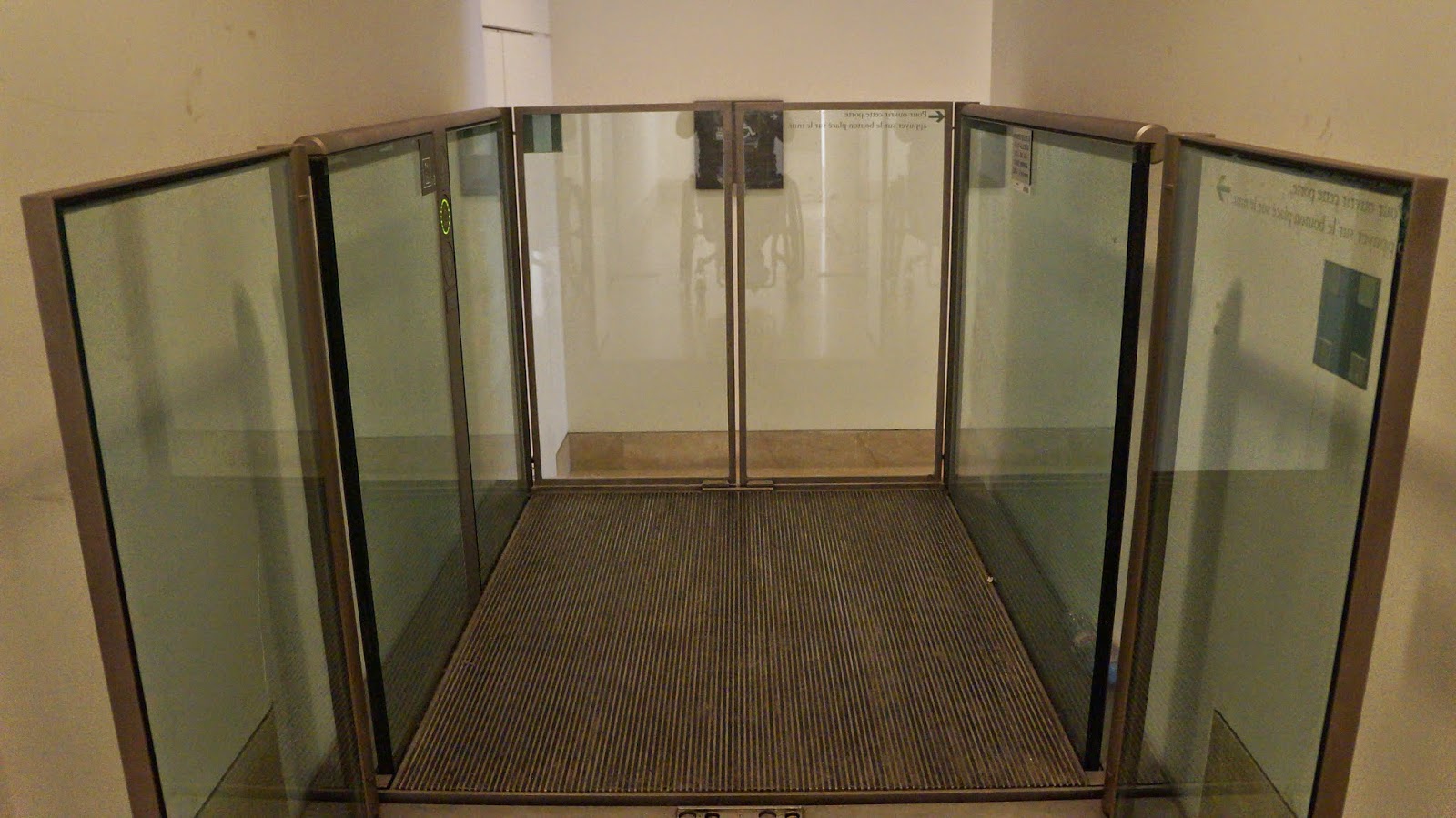Rome will definitely be a challenging city to visit for any
wheelchair user. I knew this before coming here, but I was willing to face
those challenges head-on because one of my bucket-list items was to see the
Coliseum. Yes, I did see the Coliseum, but not without some blood, sweat, and
tears.
ACCOMODATION
I booked my first Airbnb room close to Termini station to
make it easier for me to get to. That turned out to be meaningless (see below).
The host said there were no stairs and an elevator and that he had a friend in
a wheelchair visit him recently so everything would be fine. When I arrived
there were two small steps, no big deal because I can handle that. But the big
problem came when I wasn’t able to fit into the elevator! This was the first
time this had ever happened to me. I came close to not fitting into the
elevator in other cities, but this time the door was very narrow. The host had
to place a kitchen chair in the elevator for me to transfer onto and then she
carried my chair up the stairs. On the contrary, once I got into the apartment,
everything was fine. The place was very spacious and the bathroom was large
enough to get into without any issues. But not being able to get in and out of
the building was not going to work and so I immediately needed to find a new
room which was quite disappointing and a waste of precious vacation time.
Two days later, by sheer luck, I was able to find a real
wheelchair accessible room only a 10min walk from Vatican city. This was more a
like a hotel room. There was just a bed, desk, and bathroom and the best part was
that it was specifically designed for wheelchair users. There was a roll in
shower with grab bars. The only odd thing was the two steps to get into the
room. I would have preferred a room in a flat with other people I could talk
to, but at this point, I was just happy to have a suitable room and bathroom I
could use comfortably. I would recommend staying in the area of Vatican City if
you can since the sidewalks are smoother with more curb cuts.
ACCESSBILITY
The infrastructure in Rome is terrible. Italy is not exactly
a poor country so I don’t know why that is the case. Visiting Rome will
seriously test your perseverance, but with lots of planning and having proper
expectations, you can make your visit more enjoyable and less challenging.
Sidewalks
Sidewalks in Rome are absolutely atrocious. I booked my
first Airbnb room close to Termini. It was supposed to be a 15min walk, but
ended up taking almost 2 hours!
Rome sidewalks can be:
- Narrow and uneven
- broken or missing
- End randomly
- Cobblestoned – large and small
- Loose or missing cobblestone
- Without curb cuts, or only have curb cuts on one side
There was a time when I crossed the street on one side with
a curb cut, and when I got to the other side there were two steps to get up!
Roads
Roads are no better. Drivers are nuts in Rome! There are no
lanes. People just drive wherever they like on the roads. And if you’re a pedestrian
waiting to cross, you will be cut off by motorcyclists and cars turning right
every single time! There is no right-of-way for pedestrians. Be warned!
Airport
 |
| Leonardo Express |
I took the Leonardo Express from Fiumicino airport to
Termini station in central Rome. I was able to go online and book special
assistance to get from the gate to my luggage and onto the train. This can be hit or miss. The employee didn’t
know where he was going and ended up taking me on a wild goose chase through the
airport.
Anyway, the Leonardo Express was surprisingly very
accessible. I booked assistance because I was afraid the train would have steps
and thus would need help getting on. However, the train was flush with the
platform and I was able to get on an off on my own. There are designated spots
for wheelchairs and an accessible toilet. The ride takes 30min and costs 14€
each way with no discount for the disabled.
 |
| Wheelchair toilet in Vatican |
Public Transit
The most disappointing thing about Rome for disabled people
is that most forms of public transit are not accessible. The metro and trams
are not accessible at all and I knew this going in. However, I thought most of
the buses would be good. This is not the case. Some bus lines are accessible,
but many are not. For the lines that are accessible, not every bus is accessible!
And the most frustrating thing is that there’s no way to find out. The transit
web site doesn’t tell you. The only thing you can really do is just go to the
bus stop and hope for the best.
When you do find an accessible bus, you enter from the rear
door and the driver has to manually flip out the ramp. I’m not sure if there’s
a charge for disabled people, but I never paid. There was no way I was paying for that kind of service.
Taxis
Bad sidewalks combined with bad public transit, meant I had
to take taxis sometimes. The taxis in Rome are fine. There are many of them and
I saw many van taxis. However, they are not cheap and can really add up if that’s
your main form of transportation.
ATTRACTIONS / SIGHTS
If you can negotiate the shitty sidewalks and public transit
to actually get to the attractions, disabled people will be well taken care of.
I only visited two attractions due to the limited transportation options, so I
opted to visit them multiple times.
 |
| Coliseum |
I did manage to find an accessible bus to take me to the
Coliseum which is surprisingly very wheelchair accessible. The area is
surrounded by cobblestone, but it can be done slowly on your own or with some
help. Once there you can skip the ridiculous line and go straight to the counter
for a free disabled ticket. There is even an elevator to take you to the 2nd
level where it is smooth all the way around! You can go wherever you like! The
terrain is rougher on the 1st level, but you can still explore all
the areas without encountering any stairs. After that, I would recommend
checking out the Roman Forum. There will be ramps in some places and very high
curbs in others.
 |
| Vatican Museums |
The Vatican Museums are absolutely beautiful and you can
easily spend the whole day there. Admission is free for the disabled and once
inside it’s mostly flat and there are accessible toilets. The counter agent
asked me for documentation to prove that I was disabled and I just pointed to
my wheelchair. Since I didn’t have any specific documents he asked for my
passport and printed out a ticket with my full name on it. The galleries are
gorgeous and you could literally spend all day here. To get into the Sistine Chapel,
you will need to take an old school lift that goes along the railing, and then
down a narrow hallway. Once there
though, you will be in awe at how beautiful it is. I feel sorry for the guy who
has to yell out all day long “no photos please”.
To get into St. Peter’s Basilica, you will need to exit
the
museums and go outside and around. There’s another huge line, but just skip it
and go straight to the front. There’s no admission fee for anyone. Take the
elevator up and then the ramp to get inside. I thought Sagrada Famalia was an
amazing church, but this one blows it out of the water! The Catholics
definitely have some coin. The architecture, the lights, the sounds, the
sculptures and artwork are all breathtaking.
 |
| Ramp into St. Peter's Basilica |
 |
| St. Peter's Square |
After that, be sure to spend time in St. Peter’s Square.
Seeing this in person was a surreal experience. That balcony where the Pope comes out to
address the people, is an image I had only seen on TV. And now I was actually
here. I spent a lot of time just hanging out and strolling around in this area.
 |
| Be sure to try the ice cream from Lemongrass Gelato |
I didn’t do any nightlife in Rome and that is because I
couldn’t get to them on public transit. Even if I took a taxi, I may not have
been to cross the street on my own. So I chose to skip the nightlife altogether
in Rome. I did find some other unique delights. I ate ice cream every day and
it was some of the best ice cream I’ve ever had! This may be a cliché, but I
did eat some very good pizza and pasta!
Overall, I am sad to say that Rome is the first city I have
visited where I am confident I would not return. I am still happy that I came
here and got to see some of the most famous and recognized places on the
planet, but the nightmare challenges I faced trying to get around could not
entice me to return.






























